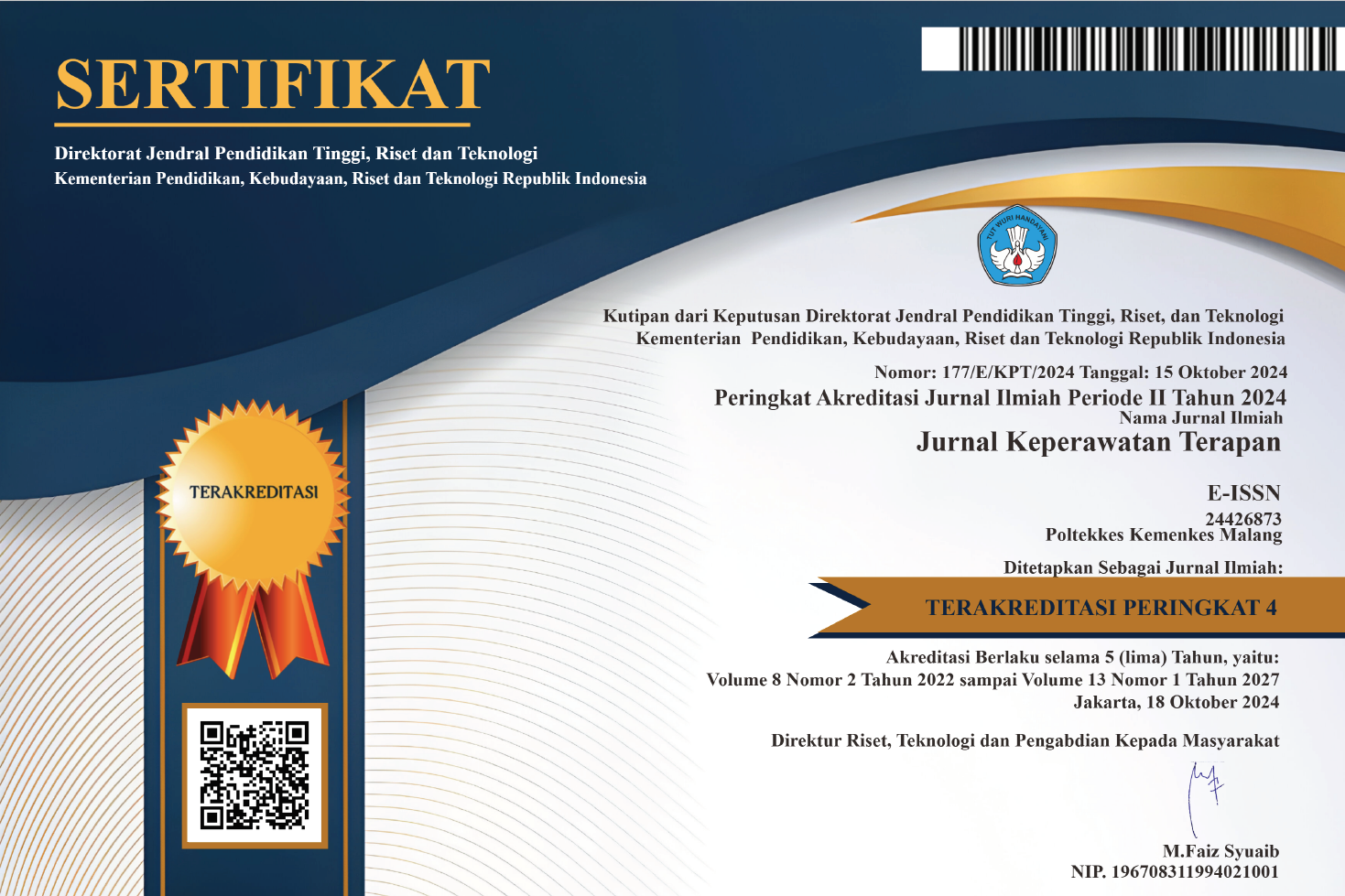Hubungan Riwayat Merokok Dengan Nilai Ankle Brachial Index di Wilayah Kerja Puskesmas Gribig Kota Malang
DOI:
https://doi.org/10.31290/jkt.v8i1.1860Keywords:
Keywords: Smoking History, Ankle Brachial Index (ABI).Abstract
Smoking is something we often encounter in society and has become part of most people's routine activities. In cigarettes, there are compounds that can worsen the condition of blood vessels and blood flow which are obtained by measuring the Ankle Brachial Index (ABI) which is the ratio of systolic blood pressure in the arm to systolic pressure in the lower leg. This study aims to analyze the relationship between smoking history and the Ankle Brachial Index (ABI) value. Correlational research design, a sample of 40 respondents using purposive sampling. The research instruments used were interview sheets, measurement observation sheets and standard operating procedures for measuring the ankle brachial index. The data were processed using SPSS 25, with a is 0.05. The results showed that most categories of non smokers got an ABI value more than 1.0 to 1.2 which was categorized as normal vascularity as much as 17.5 percent, the light smoker category mostly got an ABI value more than 1.0-1.2 which was categorized as normal vascularity as much as 15 percent, the smoker category being with an ABI value more than 1.3 to 1.4 is categorized as vascularity, has an elevation of 10 percent and an ABI value more than 1.0 to 1.2 which is categorized as 10 percent normal vascularity, for the heavy smoker category an ABi value more than 1.3 to 1.4 is classified as vascularized as having elevation 15 percent. Based on the Spearmen test, it was found that the value of p is 0.564 more than a is 0.05, so that H1 was rejected. It can be concluded that there is no effect between smoking history and Ankle Brachial Index (ABI) value. It is hoped that in future studies to pay attention to other factors related to the Ankle Brachial Index (ABI) value and the measurement will be carried out using a vascular dopler.
References
Heryani, R. 2004. Kumpulan Undang-Undang dan Peraturan Pemerintah Republik Indonesia Khusus Indonesia. Jakarta: CV.Trans Info Media
Notoatmodjo, S. 2010. Metodologi Penelitian Kesehatan. Jakarta : Rineka Cipta.
Nurrahmah. 2014. Pengaruh Rokok Terhadap Kesehatan dan Pembentukan Karakter Manusia. Prosiding seminar nasional, 1 (1): 77-84.
Nursalam. 2017. Metodologi Penelitian Ilmu Keperawatan. Jakarta: Salemba Medika.
Nussbaumerova, B., Rosolova, H., Ferda, J., Sifalda, P., Sipova, I., & Sefrna, F. 2011. The Ankle Brachial Index In Type 2 Diabetes. Vnitrni Lekarstvi, 57 (3) 299-305.
Octavian, Y,. Delmi, S., & Yuniar, L., 2015. Hubungan Merokok dengan Kejadian Hipertensi pada Laki-Laki Usia 35-65 Tahun di Kota Padang. Jurnal kesehatan Andalas, 4 (2): 434-440.
PAPDI. 2010. Buku Ajar Ilmu Penyakit Dalam, Edisi IV. Jakarta: FKUI.
Permenkes RI No.28 Tahun 2013 Tentang Pencantuman Peringatan Kesehatan dan Informasi Kesehatan pada Produk Tembakau.
Rauf, R. 2013. Panduan Promosi Perilaku Tidak Merokok. Malang: Dinkes Kota Malang.
Riset Kesehatan Dasar. 2013. Jakarta: Badan Penelitian dan Pengembangan Kesehatan, Kementerian Kesehatan Republik Indonesia.
Riset Kesehatan Dasar. 2018. Jakarta: Badan Penelitian dan Pengembangan Kesehatan, Kementerian Kesehatan Republik Indonesia.
Saepudin, M. 2011. Metodologi Penelitian Kesehatan Masyarakat. Jakarta: Trans Info Media
Setiadi. 2013. Konsep dan Praktik Penulisan Riset Keperawatan Edisi 2. Yogyakarta :Graha Ilmu
Setyananda, Yashinta Octavia Gita, at all. 2015. Hubungan Merokok dengan Kejadian Hipertensi pada Laki-laki Usia 35-36. (Online)(http://jurnal.fk.unand.ac.id/index.php/jka/article/viewFile/268/257) diakses pada 12 November 2019
Shafira, Manja. 2018. Pengaruh Pengaruh Terapi Spiritual Emotional Freedom Technique (SEFT) terhadap Perubahan Nilai Ankle Brachiale Index (ABI) pada Pasien Diabetes Melitus Tipe 2 di Puskesmas Pandanwangi Malang”. ¬Malang: Skripsi Perpustakaan Poltekkes Malang.
Sitepoe, Mengku. 2013. Kekhususan Rokok Indonesia. Jakarta: Grasindo
Stanford Medicine 25. 2016. Ankle Brachial Index (Online) (http://stanfordmedicine25.
stanford.edu/the25/ankle.html,) diakses 24 September 2019.
Susilo, WH. 2012. Statistika dan Aplikasi Untuk Penelitian Ilmu Kesehatan. Jakarta: Trans Info Media
Tanuwihardjo, Susanto. 2012. Rokok Elektrik (electric cigarette). Jakarta: Repir Indoesia.
Thendria, Tessa. 2014. Hubungan antara Hipertensi dan Penyakit Arteri Perifer Berdasarkan Nilai Ankle-Brachial Index (https://media.neliti.com/media/publications/59822-none-7b68edc3.pdf) diakses pada 12 November 2019.
White CJ. 2011. Atherosclerotic Peripheral Arterial Disease. In: Goldman L, Schafer AI, eds. Goldman's Cecil Medicine. 24th ed. Philadelphia, PA: Saunders Elsevier; 2011:chap 67.
World Health Organization. 2015. Smokers Prevalence In The World. (Online)(http://WHO.tnt/countries) diakses pada 28 Agustus 2019
Wound Ostomy and Continence Nurses Society. 2010. Ankle Brachial Index: Best
Practice for Clinicans. WOCN Subcommitte.s
Wound Ostomy and Continence Nurses Society. 2012. Ankle Brachial Index:
Quick Reference Guide for Clinicans. J WOCN Published by Lippincott
Williams & Wilkins
Tawbariah. 2015. The Corelation of Consuming Cigarette with Blood Pressure of The Societyin Pasaran Island Kota Karang Village East Teluk Betung Sub-District Bandar Lampung (file:///C:/Users/acer/Downloads/293-561-1-SM.pdf) diakses pada 4 Oktober 2019
Paramita, Wida Sekarani. 2020. Rencana Usulan Kegiatan Program Usaha Kesehatan Sekolah Tahun 2021. Dinas Kesehatan Kota Malang Puskesmas Gribig.












